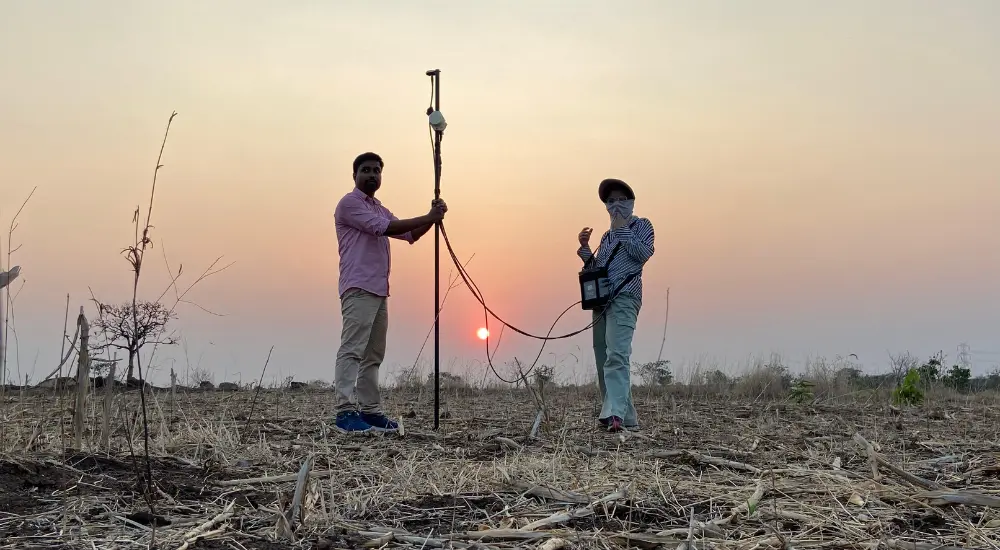16. How can magnetic methods be used in environmental studies?
(A) By measuring soil moisture content
(B) By detecting buried waste and contamination
(C) By analysing plant growth patterns
(D) By studying weather patterns
(B) By detecting buried waste and contamination
Explanation: Magnetic methods can be used in environmental studies to detect buried waste and contamination, as certain materials and pollutants may create distinctive magnetic anomalies that can be mapped and analysed.
17. What is the term for a line on a magnetic map that connects points of equal magnetic intensity?
(A) Contour line
(B) Isochron
(C) Isoline
(D) Isodynamic line
(D) Isodynamic line
Explanation: An Isodynamic line is a line on a magnetic map that connects points of equal magnetic intensity, helping to visualize the distribution of magnetic anomalies.
18. What is the purpose of using a gradiometer in magnetic surveys?
(A) To measure temperature gradients
(B) To measure magnetic field gradients
(C) To record seismic waves
(D) To detect electrical conductivity
(B) To measure magnetic field gradients
Explanation: A gradiometer is used in magnetic surveys to measure the gradients of the magnetic field, providing detailed information about the rate of change in magnetic intensity over short distances.
19. Which of the following can cause a magnetic anomaly?
(A) A change in atmospheric pressure
(B) A subsurface rock formation with different magnetic properties
(C) A variation in surface temperature
(D) An increase in groundwater levels
(B) A subsurface rock formation with different magnetic properties
Explanation: A magnetic anomaly can be caused by a subsurface rock formation with different magnetic properties, resulting in a variation in the Earth’s magnetic field at that location.
20. How can magnetic methods help in identifying fault zones?
(A) By measuring seismic wave velocities
(B) By detecting changes in magnetic susceptibility
(C) By analysing soil moisture content
(D) By recording thermal anomalies
(B) By detecting changes in magnetic susceptibility
Explanation: Magnetic methods can help identify fault zones by detecting changes in magnetic susceptibility, as faults often juxtapose rocks with different magnetic properties.
21. What is the primary component of the Earth’s magnetic field that is measured in magnetic surveys?
(A) The horizontal component
(B) The vertical component
(C) The total field intensity
(D) The dip angle
(C) The total field intensity
Explanation: The primary component of the Earth’s magnetic field measured in magnetic surveys is the total field intensity, which includes contributions from both the horizontal and vertical components.
22. What is the role of a base station in a magnetic survey?
(A) To provide a fixed reference point for magnetic measurements
(B) To record seismic data
(C) To monitor weather conditions
(D) To measure electrical conductivity
(A) To provide a fixed reference point for magnetic measurements
Explanation: A base station in a magnetic survey provides a fixed reference point for magnetic measurements, allowing for the correction of diurnal variations and other temporal changes in the Earth’s magnetic field.
23. Which type of rock is typically associated with strong magnetic anomalies due to its high iron content?
(A) Limestone
(B) Sandstone
(C) Granite
(D) Basalt
(D) Basalt
Explanation: Basalt is typically associated with strong magnetic anomalies due to its high iron content, which contributes to its strong magnetic properties.
24. What is the primary advantage of using magnetic surveys in unexplored regions?
(A) Low cost and rapid data collection
(B) High resolution of subsurface features
(C) Ability to measure electrical conductivity
(D) Direct detection of oil and gas reserves
(A) Low cost and rapid data collection
Explanation: The primary advantage of using magnetic surveys in unexplored regions is their low cost and rapid data collection, making them an efficient method for preliminary geological exploration.
25. How can magnetic methods be used to study ancient human activities?
(A) By measuring atmospheric carbon levels
(B) By detecting buried structures and artifacts
(C) By analysing tree ring patterns
(D) By studying ocean currents
(B) By detecting buried structures and artifacts
Explanation: Magnetic methods can be used to study ancient human activities by detecting buried structures and artifacts, as these often cause magnetic anomalies that can be mapped and analysed.
26. What is the term for a line on a magnetic map that connects points of equal magnetic declination?
(A) Agonic line
(B) Isogonic line
(C) Isoclinic line
(D) Isodynamic line
(B) Isogonic line
Explanation: An Isogonic line is a line on a magnetic map that connects points of equal magnetic declination.
27. What is the term for a line on a magnetic map that connects points of equal magnetic dip?
(A) Aclinic line
(B) Isogonic line
(C) Isoclinic line
(D) Isodynamic line
(C) Isoclinic line
Explanation: An Isoclinic line is a line on a magnetic map that connects points of equal magnetic dip.
28. The lines connecting points of zero magnetic declination on a magnetic map is known as
(A) Agonic line
(B) Isogonic line
(C) Isoclinic line
(D) Isodynamic line
(A) Agonic line
Explanation: An Agonic line is a line on a magnetic map that connects points of zero magnetic declination.
29. The lines connecting points of zero magnetic dip on a magnetic map is known as
(A) Agonic line
(B) Isogonic line
(C) Isoclinic line
(D) Aclinic line
(D) Aclinic line
Explanation: An Aclinic line is a line on a magnetic map that connects points of zero magnetic dip.










